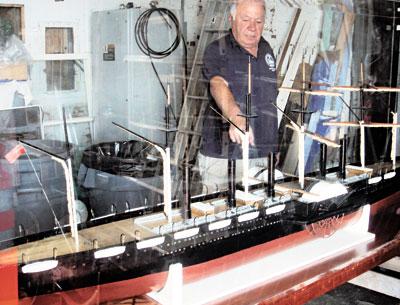Great Eastern Is in Montauk to Stay

At 2 a.m. on Aug. 17, 1862, one mile east of Montauk Point, the S.S. Great Eastern, the largest ship in the world at the time, struck a rock that would forever bear its name.
It was the ship’s third passage to New York Harbor, with 1,530 passengers. Their combined weight, when added to the ship’s 18,915 gross tons and its cargo, increased the draft of the ship to 30 feet. The rock she hit lies 24 feet below the surface. The Great Eastern, originally called Leviathan by the newspapers of the day, was 695 feet long with an 82-foot beam.
In August, Dick White and Brian Pope of the Montauk Lighthouse Museum traveled to Maine to offer the winning bid, $7,500, on an exact eight-foot-long steel model of the Great Eastern. The scale model is intricately fashioned with decks that can be lifted to reveal two working kerosene-fired steam engines.
The prior owner bought it from an antiques shop in Greenwich, England. But who built it, and when? The Lighthouse Museum, which had been tipped off to the auction by George Nama, a Montauk resident, artist, and collector, is now engaged in a search for the name of the artisan.
Meanwhile, the model will be put on display at the museum, very likely next to a window that looks out on the spot where the great ship ran aground during the Civil War 150 years ago. Today, Great Eastern Rock is a popular fishing spot.
No one was hurt when the Great Eastern struck the tallest of a number of high points in the rocky offshore leavings of the last glacier. The ship, bound for Flushing Bay, had weathered a gale the day before, and Capt. James Walker decided to wait off Montauk before entering Long Island Sound. A pilot was brought aboard at 1:30 a.m. As the ship moved forward, a rumble was felt. A check for damage revealed a leak that resulted in a slight list to port, but the Great Eastern was freed from the rock with only the loss of an anchor, and made it to New York.
The collision had opened an 83-foot-long gash in the hull, but Great Eastern was not in danger of sinking. She was actually two ships, one iron hull inside another, with a honeycomb of transverse bulkheads between them to prevent flooding. She was the first ship to have this now-standard design.
Her designer was Isambard Kingdom Brunel, an engineer and bridge-builder who conceived of the Great Western Railway. Its tracks spanned Britain east to west, with transport continuing across the ocean via iron steamships of his design.
Great Eastern’s business plan included competing with clipper ships, the fast, sail-powered freight carriers of the age. And, she was to take advantage of the growing popularity of trans-Atlantic travel, which included greater and greater numbers of European emigrants. To compete with the clippers, Great Eastern was powered by four coal-fired steam engines that drove 56-foot-diameter paddle wheels as well as a stern propeller over 20 feet across.
The ship also carried six masts with both square-rigged and fore-and-aft rigged sails for a total sail area of 18,000 square feet. The sails did not work out, at least while the paddle wheels were turning. Hot exhaust from the ship’s five stacks tended to set the sails on fire. Nonetheless, Great Eastern could make 14 knots.
By August of 1862, the North and the South were nearly two years into the Civil War, which not only reduced the number of paying trans-Atlantic travelers but held up repairs to the Great Eastern. Back at sea, she made a number of round trips between the U.K. and America before being converted to a cable-laying vessel. The Great Eastern laid not the first trans-Atlantic cable, but the first one to last.
In retrospect, except for her cable-laying, she seemed to have been born under a bad sign. A boiler explosion killed several hands on her maiden voyage in 1858, a contract to carry mail across the Atlantic fell through, and the Civil War destroyed her passenger trade. In the end she plied the Mersey River as a floating music hall and billboard for a department store.
The Great Eastern was broken up in 1889. One of her masts survives, however, as a flagpole at the Anfield football stadium in Liverpool.
Reached on Tuesday, Mr. Nama described how the model came to his attention. He admitted to being the type of artist who collects — “I’m a collector type of guy” — in this case, old illustrations, which included a number of intricate wood engravings that appeared in several publications around the time of the Great Eastern’s launching. “They include a lot of information,” Mr. Nama said. In fact, the prints offer photographic-like depictions of her great size, alongside sailing ships of the day.
Mr. Nama said a friend he knew from The Old Print Shop on Lexington Avenue, a man who likes fishing with a father who lives on the North Fork, called and said, “‘You have a Great Eastern Rock out there. Do you know anyone who might be interested in a model of the ship?’”
Mr. Nama said he informed Greg Donohue, a member of the Lighthouse Museum Committee, who passed on the details to Mr. Pope, the museum’s assistant site manager, and Mr. White, chairman of the committee.
The model was previously owned by Friedrich von Huene of Phippsburg, Me., who bought it in England in the 1980s. Last May, Mr. von Huene’s daughter arranged for it to be auctioned at the Thomaston Place Auction Galleries in Maine.
In a letter to the auction house, Mr. von Huene suggested that “the model is working and is ideal for a father with impressionable children.” Plenty of those visit the Montauk Point Lighthouse Museum each year.
